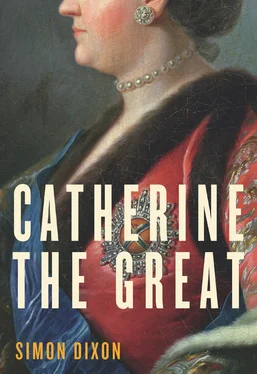Another of her secretaries’ functions was to dispense her largesse as Catherine allocated funds from the Closet and other sources to favoured friends and advisers. As a sop for Zubov’s inexorable rise, Bezborodko received 50,000 roubles from the postal taxes on New Year’s Day 1795, with a pension of 10,000. On 18 April, another 50,000 was sent to Suvorov in Warsaw. (When he stayed at the Tauride Palace later in the year, wandering about in various states of undress, the empress thought him ‘a very strange individual. He is very erudite, and naturally very talented, but infinitely eccentric, in ways which do him no good.’) There were the customary Easter presents for courtiers and servants, mostly in the form of new uniforms and dresses at a cost of 21,900 roubles (by 1796, the price had risen to 25,300 roubles). Property had always been one of the empress’s greatest gifts. In January, she bought Count Osterman’s house on Millionnaya for 150,000 roubles and gave it to Prince Repnin; in April she paid 160,000 roubles for Andrey Shuvalov’s house on the Moika and presented it to Alexandra Branicka, furnished and fitted out with new mirrors from Potëmkin’s glassworks. Foreign dignitaries were given more intricate treasures. In July she sent a snuffbox with her portrait on it, valued at 11,656 roubles, to Prime Minister Pitt; the Austrian foreign minister Baron Thugut received another worth 14,000 roubles in September. Aleksey Orlov had been sent a more personalised gift in July: ‘I would have put in it snuff from tobacco grown in my own garden, for I take no other, but I was worried that it would dry out on the journey.’ Meanwhile she had paid for the transport of a Herschel telescope, presented to her by George III, and given another 3229 roubles to Ivan Kulibin, the inventor from Nizhny Novgorod to whom she had first been introduced on the Volga cruise in 1767. Fëdor Shubin received 3000 roubles for a waxwork of Joseph II. 83
For an ageing empress, the length and frequency of Orthodox services was an increasing irritation, especially in Lent when she might spend up to eight hours a day in the palace chapel. 84The Church nevertheless had its uses as a bastion against revolutionary excess: ‘for my part,’ Catherine proclaimed tongue in cheek to Grimm in February 1794, ‘I propose that all the Protestant powers should embrace the Greek religion to preserve themselves against this irreligious, immoral, anarchical, evil and diabolical plague, the enemy of throne and altar. It is the sole apostolic and truly Christian [faith]’. 85In the circumstances, it was all the more important to continue to make lavish donations as a public expression of her religious commitment. In 1790, she commissioned two sets of liturgical plate from Iver Buch, the son of a Danish goldsmith who had worked in Russia since 1776. Each set was studded with diamonds from the treasury and ‘antique stones’ from her own collection in the Hermitage. While one was sent to the Dormition Cathedral in Moscow, the other was presented to the Trinity Cathedral at the Alexander Nevsky monastery at the annual celebrations on 30 August 1791. 86Further internal gilding there, costing over 24,000 roubles, was paid for by February 1795, and in May of that year she spent another 90,000 roubles on marble to rebuild the ageing Kazan Church. 87
Although the upkeep of the palaces constituted another drain on the imperial purse—in June 1795, 68,193 roubles had to be set aside to repair General Bauer’s water-supply system at Tsarskoye Selo—Catherine was as usual more parsimonious with her own accommodation. 88The secretary with responsibility for the royal residences was Suvorov’s old comrade Peter Turchaninov, ‘a little slip of a man, and so addicted to bowing and scraping that he only seemed half as high as he was’. 89In preparation for the empress’s visit to Tsarskoye Selo after Easter 1795, he instructed the Court administration on 8 April to furnish the Chinese pagodas with curtains and leather chairs. Twelve days later came a characteristic amplification: ‘1) do not make fringes and tassels for the curtains; 2) only hang the smallest icons; 3) mirrors at 25 roubles each; 4) use old dressing-tables and commodes and buy only what cannot be supplied from these; 5) black leather chairs are much cheaper, on no account purchase any armchairs; 6) also use old stone wash-basins’. ‘Listen,’ Catherine once told Grimm, ‘the thing I like least in the world is to speak about finances.’ Still, she was anxious that the Court had been running a 2-million-rouble deficit on an annual turnover of 3 million since 1789. Caution even came through in the autumn preparations for Constantine’s wedding to Princess Juliana Henrietta of Sachsen-Coburg. The upper floor of the Marble Palace was to be furnished for the empress and several guests, but only ‘for the shortest possible time’ so that everything could be taken ‘back to where it belongs’. Even so, 118,528 roubles were set aside over the course of 1796 and 1797 to convert new Winter Palace apartments for the groom. 90
Though Constantine’s wedding had to be postponed when the bride was struck down by toothache, it went ahead in February 1796 with all the customary banquets, balls and fireworks. ‘So far I am very well,’ Catherine reported to Grimm in the middle of the whirl, after being told that she seemed as merry as a lark: ‘and that is a very good compliment I have been given at the age of sixty-seven’. 91Alexander had already married the fourteen-year-old Princess Louise of Baden-Durlach in September 1793 (‘everyone said that it was two angels who were betrothed’). 92The empress had always revelled in the preparations for such nuptials, and these were especially important as they seemed to presage a happy and glorious future for the two boys she had brought up as her own. Other family news was less welcome. She scarcely troubled to conceal her disappointment when Maria Fëdorovna gave birth to another girl, Olga, on 11 July 1792. Fretting that a clutch of expensive grand duchesses would be left on the shelf, the empress resented everything from the costs of their upkeep (from jewels for the newborn child down to the single rouble given to each of the palace sentries) to the complications their birthdays and name days would bring to an over-crowded Court calendar. Even so, she was distraught when Olga died less than three years later. While teething, the child had ‘developed such a hunger that she wanted to eat all the time,’ Catherine explained to Grimm on 16 January 1795. ‘After sixteen weeks of suffering and a slow consumptive fever came 24 hours of terrible agony.’ Four days later, dressed in deep mourning, the empress braved the cold to travel to the funeral at the Alexander Nevsky monastery, accompanied in her carriage by her two eldest granddaughters Alexandra and Yelena. Though it was greeted by rejoicings at Court, the birth on 7 January of a sixth granddaughter, Anna, was scant compensation. 93Not until her last grandchild, the future Nicholas I, came into the world on 25 June 1796, did the prospects for the dynasty seem to improve. ‘His brothers will prove to be dwarfs before this colossus,’ Catherine boasted to Grimm: ‘his hands are only a bit smaller than my own.’ 94
By then her own horizons were already shrinking. ‘I am old, too,’ she had confessed as she grieved for Potëmkin in October 1791. 95Six months later, Khrapovitsky found among her papers an undated will in her own hand, specifying various burial grounds depending on her place of death. Should it occur at Tsarskoye Selo, she wanted to be interred (alongside the unmentioned Alexander Lanskoy) in the cemetery at Sofia; if she died in St Petersburg, then she must be buried in the Alexander Nevsky monastery. Its Trinity Cathedral, as a later note made clear, had been ‘built by me’: there was no mention of the imperial necropolis at the Peter-Paul Cathedral, indelibly associated with Peter the Great. ‘Lay out my corpse dressed in white, with a golden crown on my head, and on it inscribe my Christian name. Mourning dress is to be worn for six months, and no longer: the shorter the better.’ 96Increasingly conscious of the passage of time, she observed mordantly to Grimm in February 1794, the fiftieth anniversary of her arrival in Russia, that there were now barely a dozen people who could remember the event, one of whom was Lev Naryshkin, who denied it for fear of appearing aged, and another Ivan Shuvalov, ‘who scarcely leaves his house as a result of his decrepitude’. 97That same month, William Gould told John Parkinson that ‘though the empress looks very well when made up, she appears very much otherwise in dishabille, indeed with strong symptoms of old age’. 98In public, Catherine wore ‘a great deal of rouge, for she was still desirous to prevent the impressions of time from being visible on her face’. 99In the relative privacy of her own apartments, she received ambassadors in a simple white negligee, using spectacles and a magnifying glass for reading. Her hair was worn low, a simple old-fashioned style, with curls behind the ears. 100It was an image of vulnerability soon to be attacked by her Western detractors. In his controversial Secret Memoirs of Russia , published in Paris soon after her death, Charles Masson described the allegedly toothless empress as ‘fat to the point of deformity’, mocking her faith in a Greek client of Zubov, the piratical Colonel Lambro-Kochoni, who prescribed seawater for the ulcers that disfigured her legs. 101
Читать дальше












